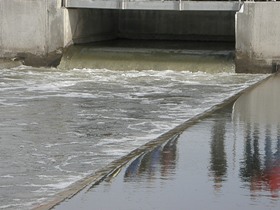
DEVILS LAKE, N.D. (DLOMAC) – The Devils Lake Outlets Management Advisory Committee (DLOMAC) voted to run the lake’s east and west end outlets at maximum allowable capacity.
As a result, the North Dakota Department of Water Resources (DWR) anticipates starting to run the outlets beginning May 1, provided forecast temperatures will be above freezing and all preparation work is complete.
“With ongoing flooding challenges throughout the Devils Lake region, including thousands of acres of farmland still under water, it’s good to know we have support for a potential outlet start-up date of May 1,” Jeff Frith, Devils Lake Basin Joint Water Board Manager and Water Commission member said. “The longer the pumping season, the better opportunity we have to continue making progress toward lowering the lake.”
At maximum capacity, the Devils Lake outlets can discharge a combined 600 cubic feet per second (cfs), with 250 cfs from the west end and 350 cfs from the east end. Water quality and downstream channel capacity can limit releases.
“The Devils Lake outlets continue to be a vital component of the state’s comprehensive approach to reducing flood-related impacts in the Devils Lake basin,” Department of Water Resources Director Andrea Travnicek said. “And while the state remains committed to removing as much floodwater as possible this summer, we are also committed to monitoring water levels and water quality in consideration of the people who rely on the Sheyenne and Red Rivers downstream.”
During the April 16th annual DLOMAC meeting in Devils Lake, the DWR, North Dakota Department of Environmental Quality, and National Weather Service presented updates for the 17-member committee who represent the Devils Lake, Sheyenne, and Red River basins, including members from Minnesota and Manitoba, Canada.
In 2023, the maximum combined discharge from the outlets peaked at 400 cfs. According to the DWR, the Devils Lake outlets discharged 88,064 acre-feet of water in 2023, the highest volume since 2018. The discharge from the outlets resulted in an estimated one-half foot drop in lake level in 2023. The west end outlet operated 159 days in 2023, and the east end outlet operated 98 days. The lake’s elevation was 1,449.4 feet as of April 18, and is expected to stay at approximately that level through the year.
